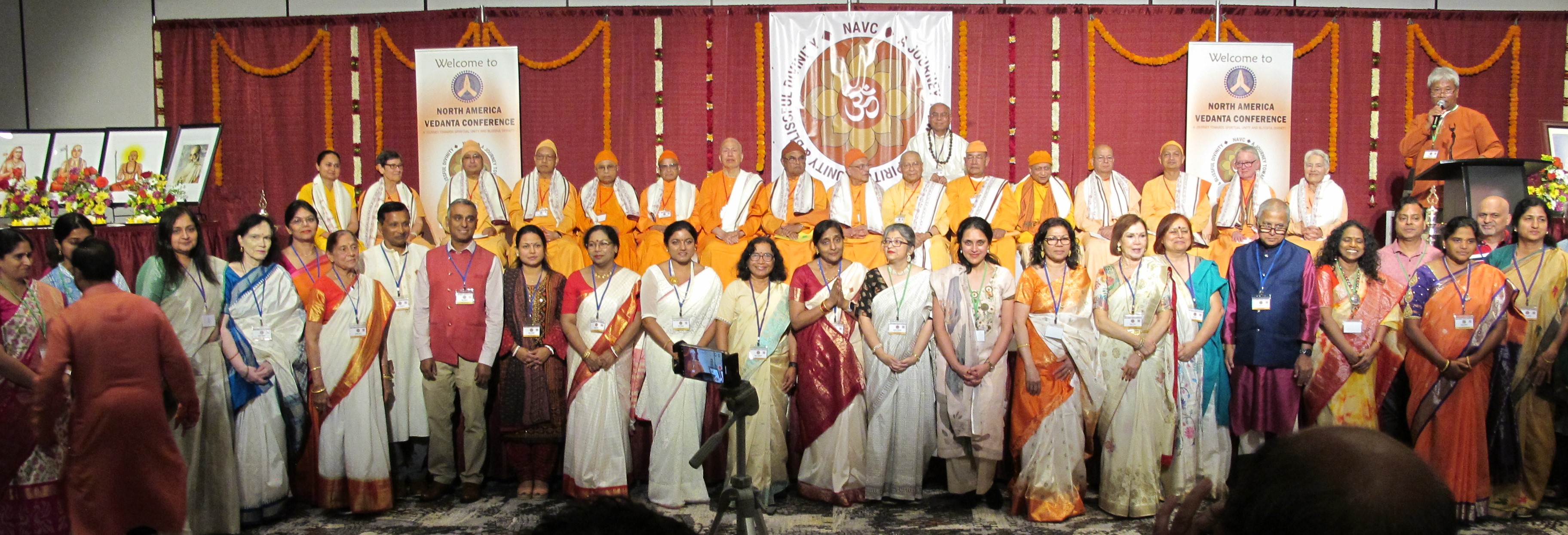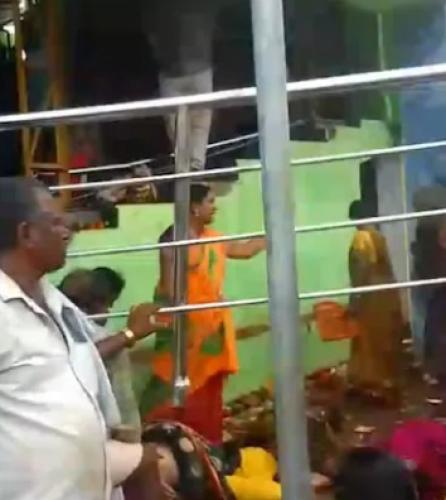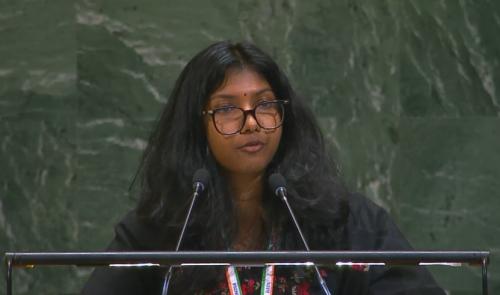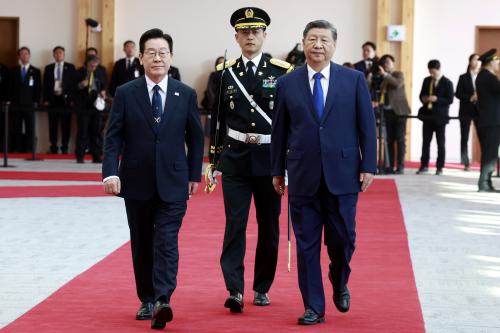By Ravi R Ponangi
With inputs by Pudipeddi Seshu Sarma
Huntsville, Alabama: The first ever North America Vedanta Conference (NAVC) was a landmark gathering that left an indelible mark on the spiritual landscape of this continent. Far more than an academic symposium, it was an uplifting, transformative experience that sought to bridge timeless spiritual wisdom with the challenges and aspirations of modern life. From September 12 to 14, the Von Braun Center in Huntsville, Alabama became a vibrant hub of reflection, dialogue, and devotion, where more than 400 participants gathered to explore the teachings of Vedanta. For the first time in history, all four major schools of Vedanta—Advaita, Vishishtadvaita, Dvaita, and Samanvaya Vedanta—were presented and discussed at one forum by sixteen revered speakers representing respected institutions such as the Ramakrishna Order and the Chinmaya Mission.
The lineup of speakers itself was remarkable, representing decades of study, practice, and service. Among them were Swami Sarvadevananda, Head of the Vedanta Society of Southern California; Swami Prapannananda, Head of the Vedanta Society of Sacramento; Swami Ishatmananda, Head of the Vivekananda Vedanta Society of Chicago; Swami Ishtananda, Head of the Vedanta Center of St. Petersburg, Florida; Swami Yogatmananda, Head of the Vedanta Society of Providence; Swami Tyagananda, Head of the Ramakrishna Vedanta Society of Boston; Swami Kripamayananda, Head of the Vedanta Society of Toronto; Swami Tattwamayananda, Head of the Vedanta Society of Northern California; Swami Prasannatmananda, Head of the Vedanta Society of Berkeley; Swami Chandrashekharananda, Head of the Vedanta Society of Portland; Swami Satyamayananda, Head of the Vedanta Society of Western Washington; Swami Sarvapriyananda, Head of the Vedanta Society of New York; Pravrajika Brahmaprana of the Ramakrishna Vedanta Society of North Texas; Pravrajika Vrajaprana of the Sarada Convent, Vedanta Society of Southern California; Pravrajika Virajaprana of the Vedanta Convent, Vedanta Society of San Francisco; and Brahmacharini Jyoti Chaitanya of the Chinmaya Mission in Atlanta. The diversity of voices reflected both the depth and the universality of Vedantic philosophy.
The Hindu Cultural Center of North Alabama, under the guidance of Pujya Swami Ishatmananda Ji, hosted the three-day event. Dr. Subir Paul, convener of the conference committee, along with a dedicated team of volunteers, worked tirelessly to ensure the success of this monumental undertaking. Their efforts bore fruit as the conference unfolded seamlessly—three days, four schools of Vedanta, five sessions, sixteen speakers, and more than four hundred attendees. By any measure, it was a tall order, yet it was executed with grace, devotion, and precision.
The opening session set the tone with Swami Sarvapriyananda introducing the foundational principles of Vedanta and outlining its major divisions. The first day focused on Dvaita Vedanta, with speakers presenting the dualistic school of thought that emphasizes the eternal distinction between the individual soul and the Supreme. The teachings of Madhvacharya, Jayatirtha, Vyasa Teertha, Purandara Dasa, and other luminaries were elaborated upon, tracing the journey of dualism before, during, and after the period of Chaitanya Mahaprabhu.
The second day was divided into three sessions and proved to be the intellectual and spiritual heart of the conference. The morning session was dedicated to Vishishtadvaita, the philosophy of qualified non-dualism. Scholars highlighted the contributions of the Alwars, Nayanars, Andal, Natha Muni, and Yamunacharya, all of whom laid the foundation for Ramanujacharya’s monumental work, the Sri Bhasyam. The discussions further delved into the theological and sectarian differences that emerged in the post-Ramanuja period, emphasizing the works of Vedanta Desika and others who shaped the later tradition.
The midday session turned to Advaita Vedanta, the school most famously articulated by Adi Shankara. While acknowledging that non-dualistic thought had existed since the Vedic period, speakers traced its development before, during, and after Shankara’s lifetime. References were made to early Advaitins such as Atreya, Katyayani, and Bhartrihari, followed by an exploration of Adi Shankara’s systematic consolidation of Advaita. Later Advaitins like Sri Ramakrishna and Swami Vivekananda were also discussed, underscoring how Advaita has continued to inspire seekers across centuries. A notable feature of this session was the emphasis on women Advaitins such as Gargi and Vagdevi, whose intellectual and spiritual contributions are too often overlooked in traditional narratives.
The final session of the day focused on Samanvaya Vedanta, or the philosophy of synthesis and harmony. As practiced and taught by Sri Ramakrishna Paramahamsa and Swami Vivekananda, this school emphasizes the unity underlying the diverse approaches within Vedanta. It celebrates the idea that truth is one though expressed in multiple forms, a principle deeply resonant in today’s pluralistic world.
The third and final day turned attention to perhaps the most pressing question of all: the relevance of Vedanta in modern life. This session emphasized how timeless teachings can be woven into the fabric of daily existence, offering guidance for inner peace, harmony, and spiritual fulfillment in a rapidly changing world. Swami Sarvapriyananda moderated most of the sessions throughout the conference, while the Samanvaya Vedanta session was skillfully guided by Swami Tyagananda of Boston.
A defining characteristic of the conference was its integration of philosophy with devotion. Swami Ishatmananda led stotra recitals and meditation sessions, ensuring that the atmosphere was not purely intellectual but deeply spiritual. This blending of discourse and practice enabled participants to not only think about Vedanta but also experience its transformative power. The emphasis throughout was not just on intellectual understanding but on personal spiritual realization, enlightenment, and liberation.
Speakers reminded participants that Vedanta is not a relic of the past but a living tradition rooted in the Upanishads, the Bhagavad Gita, and the Brahma Sutras. Over thousands of years, various commentaries on these texts gave rise to multiple schools of Vedanta. These schools are not contradictory but complementary, offering seekers different pathways toward the same ultimate truth. The conference highlighted this unity within diversity, reminding attendees that Vedanta’s core values remain central to Hinduism and relevant to humanity at large.
The presence of devotees and scholars from different cities and even from India underscored the global appeal of Vedanta. As Swami Ishatmananda remarked, the collective spirit of those who gathered demonstrated the strength of community and the shared purpose of advancing Vedantic wisdom. The Vedanta Societies in America, which were originally established to support the work of the Ramakrishna movement, have played a crucial role in introducing Hindu thought to the West. They have been instrumental not only in spreading Vedanta and yoga but also in offering spiritual instruction, social service, and guidance to countless seekers. Though smaller in number compared to other religious institutions, their influence on America’s spiritual landscape has been profound.
The conference also served as a reminder of Swami Vivekananda’s pioneering work in bringing Vedanta to America in 1893 at the Parliament of the World’s Religions in Chicago. His vision continues to unfold today through the efforts of monks, nuns, and lay devotees who carry forward the mission of making Vedantic wisdom accessible to all. The NAVC was, in many ways, a continuation of that legacy, offering fresh perspectives and renewed inspiration.
Participants left Huntsville with much more than intellectual enrichment. They carried with them practical insights into how Vedantic teachings can guide day-to-day living, fostering peace, happiness, and a deeper connection to the divine. For many, the conference was both a spiritual homecoming and a new beginning, a chance to align personal practice with universal truths.
The first North America Vedanta Conference will be remembered not only for its scholarly rigor and devotional atmosphere but also for its vision of unity and transformation. It was a true celebration of Vedantic tradition, its living relevance, and its power to inspire seekers across cultures and generations. Memories of the event, captured in photographs, remain a testament to this historic gathering: https://photos.app.goo.gl/tF4wkuMh9Mvfj6E36.











